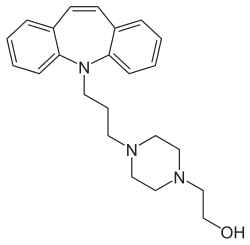This article needs additional citations for verification. (August 2017) |
 | |
 | |
| Clinical data | |
|---|---|
| Trade names | Insidon, Pramolan, others |
| Other names | G-33040; RP-8307[1] |
| AHFS/Drugs.com | International Drug Names |
| Routes of administration | Oral |
| ATC code | |
| Legal status | |
| Legal status | |
| Pharmacokinetic data | |
| Bioavailability | 94%[3] |
| Protein binding | 91%[3] |
| Metabolism | CYP2D6-mediated[3] |
| Elimination half-life | 6–11 hours[3] |
| Excretion | Urine (70%), feces (10%)[3] |
| Identifiers | |
| |
| CAS Number |
|
| PubChem CID | |
| ChemSpider | |
| UNII | |
| KEGG | |
| ChEMBL | |
| CompTox Dashboard (EPA) | |
| ECHA InfoCard | 100.005.687 |
| Chemical and physical data | |
| Formula | C23H29N3O |
| Molar mass | 363.505 g·mol−1 |
| 3D model (JSmol) | |
| |
| |
| | |
Opipramol, sold under the brand name Insidon among others, is an anxiolytic and tricyclic antidepressant that is used throughout Europe.[1][4][5][6][7] Despite chemically being a tricyclic dibenzazepine (iminostilbene) derivative similar to imipramine, opipramol is not a monoamine reuptake inhibitor like most other tricyclic antidepressants, and instead, uniquely among antidepressants, acts primarily as a SIGMAR1 agonist.[7] It was developed by Schindler and Blattner in 1961.[8]
- ^ a b Cite error: The named reference
Elks2014was invoked but never defined (see the help page). - ^ Anvisa (2023-03-31). "RDC Nº 784 - Listas de Substâncias Entorpecentes, Psicotrópicas, Precursoras e Outras sob Controle Especial" [Collegiate Board Resolution No. 784 - Lists of Narcotic, Psychotropic, Precursor, and Other Substances under Special Control] (in Brazilian Portuguese). Diário Oficial da União (published 2023-04-04). Archived from the original on 2023-08-03. Retrieved 2023-08-16.
- ^ a b c d e Cite error: The named reference
Mohapatra_2013was invoked but never defined (see the help page). - ^ Cite error: The named reference
IndexNominum2000was invoked but never defined (see the help page). - ^ Cite error: The named reference
Drugs.comwas invoked but never defined (see the help page). - ^ Möller HJ, Volz HP, Reimann IW, Stoll KD (February 2001). "Opipramol for the treatment of generalized anxiety disorder: a placebo-controlled trial including an alprazolam-treated group". Journal of Clinical Psychopharmacology. 21 (1): 59–65. doi:10.1097/00004714-200102000-00011. PMID 11199949. S2CID 27014778.
- ^ a b Müller WE, Siebert B, Holoubek G, Gentsch C (November 2004). "Neuropharmacology of the anxiolytic drug opipramol, a sigma site ligand". Pharmacopsychiatry. 37 (Suppl 3): S189–S197. doi:10.1055/s-2004-832677. PMID 15547785. S2CID 260238755.
- ^ Grosser HH, Ryan E (February 1965). "Drug Treatment of Anxiety: A Controlled Study of Opipramol and Chlordiazepoxide". The British Journal of Psychiatry. 111 (471): 134–141. doi:10.1192/bjp.111.471.134. PMID 14270525. S2CID 40241272.